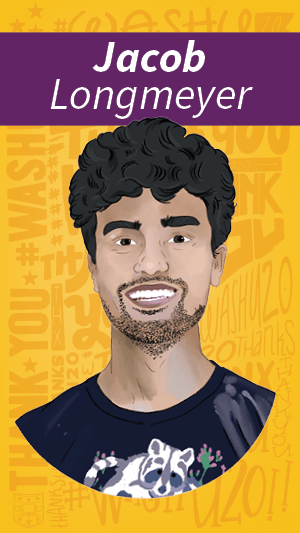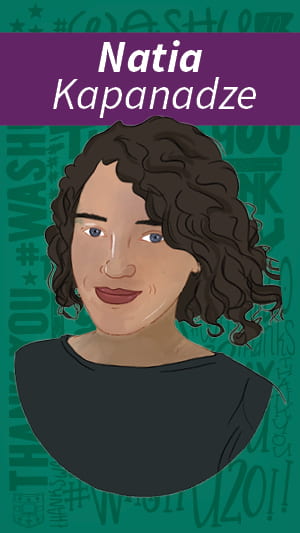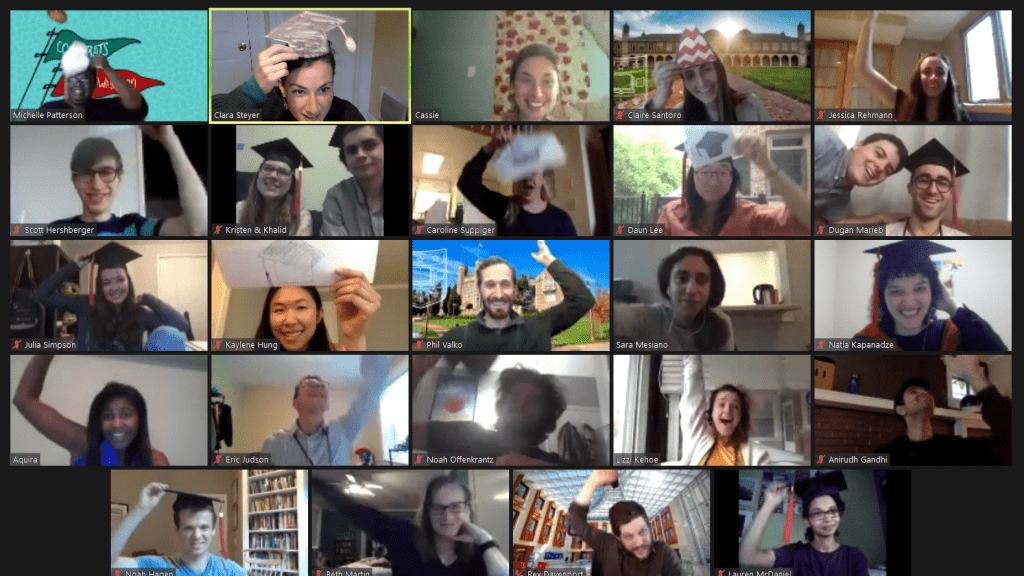This year’s Postcards of Appreciation released by Public Affairs to express WashU’s gratitude to the Class of 2020 include many students with whom we had the chance to work with!
To Natia, Jacob, Scott, Tessa, and the MANY others from the Class of 2020 who contributed to sustainability efforts at WashU, in the St. Louis community, and the world!
Jacob Longmeyer
In middle school, Longmeyer asked his parents for a plant for Christmas.
“It’s called a pregnant onion, but it isn’t actually an onion,” Longmeyer explained. “It’s also not pregnant.” His unconventional gift request was granted, and by the end of high school, he had collected more than 80 plant species.
Longmeyer’s fascination with plants eventually led him to Tyson Research Center, where he has contributed to research projects and conservation efforts. He is set to graduate this month with a degree in environmental biology from Arts & Sciences.

Longmeyer began working at Tyson as part of a research group that studies interactions among soil organisms and plants. The next summer, he joined a landscape architecture project. Most recently, Longmeyer has taken a leadership role in the Tyson Conservation Corps (TCC), a student-led organization dedicated to conservation and ecological restoration.
“As TCC student coordinator during the 2019-2020 academic year, Jacob builds community among his peers and connects them with valuable training and networking opportunities,” said Solny Adalsteinsson, staff scientist at Tyson Research Center. “Importantly, he brings people together with a personal warmth that creates a welcoming community, whether by adding his artistic flair to events or baking tasty acorn muffins to share with the group.”
“A lot of people at WashU are not from St. Louis, so many of them aren’t familiar with this environment and the plants that grow around here,” Longmeyer said. “It’s cool to bring people out to Tyson and watch them become interested in the nature around them.”
Born in Rolla, Longmeyer’s family moved to Pleasant Hill, Mo., when he was in third grade. He said Tyson reminds him of the forests and hills he grew up around. He credits coursework with Doug Ladd, senior lecturer in environmental studies in Arts & Sciences and at the Sam Fox School, and a meaningful experience with the MARC USTAR program for helping to cement his research interests in ecology.
This summer, Longmeyer plans to work with Eleanor Pardini in Arts & Sciences, surveying an endangered lupine plant along the Point Reyes National Seashore, north of San Francisco. Then he will stay on at Point Reyes to work with the National Park Service for six months before applying to graduate school.
Natia Kapanadze
Thank you, Natia Kapanadze, for helping us see the natural world with fresh eyes.
Born and raised in the Republic of Georgia, Kapanadze studied landscape architecture at the Tbilisi State Academy of Arts, then spent two years on staff at the National Botanical Garden. She supervised plantings, coordinated events and helped organize the garden’s first national Green Expo.
But “landscape architecture is a fairly new field in Georgia,” she says. Projects were typically limited in scale: the park, the yard, the patio. “The mindset was very narrow. I wanted to expand it. I wanted to experience new environments and different communities.”

As a Master of Landscape Architecture candidate in the Sam Fox School of Design & Visual Arts at Washington University in St. Louis, Kapanadze has turned her sights to the scale of the street, the river, the watershed. Last fall, she won an American Society of Landscape Architects student merit award for a speculative project that would use strategic regrading and plantings at the Ohio and Mississippi river confluence to reduce nitrogen flow into the Gulf of Mexico.
With classmate Samuel Bell-Hart, Kapanadze also spent months investigating how the Public Land Survey System (a.k.a. the Jeffersonian Grid) has reshaped sedimentation and settlement patterns across the upper Mississippi. The resulting maps, laser-scored onto plexiglass, were featured in a pop-up exhibition atop a Continental Cement Company silo on the river north of downtown.
Other projects include designing information boards for the university’s Office of Sustainability and producing videos in conjunction with the Mildred Lane Kemper Art Museum exhibition “Ai Weiwei: Bare Life.” With classmate Lauren McDaniel, Kapanadze organized a screening of videos, created for assistant professor Eric Ellingsen’s “Visualizing Ecological Processes” course, at the Griot Museum of Black History. Her degree project, “Soundscapes,” investigates ways to re-introduce natural sounds into urban environments currently dominated by traffic noise.
“WashU is very experimental,” she says. “It offers a set of tools and techniques but also allows you to explore your own interests — and not only at the theoretical level. You can go out to the floodplains, study the confluences, and see how the city is divided. It’s a great place to get a broad understanding of the field.”
Scott Hershberger
Thank you, Scott Hershberger, for explaining it all so clearly.
For his first three years of college, Hershberger was aiming toward a future as a research professor. It was the default path for him, but it wasn’t a perfect fit.
“I love math and physics — it’s so cool to explore the most fundamental aspects of our universe — but it never felt quite right for me to make that my career,” Hershberger said. “I’ve become increasingly interested in how science travels from the lab bench to the public sphere, and increasingly worried by the disconnect in that process.”
Hershberger took an internship with The Ampersand his senior year, reporting on topics as diverse as molecular muscles and “emergent simplicity.” Based on this experience, Hershberger was awarded an AAAS Mass Media Fellowship to spend 10 weeks this summer writing for Scientific American. After that, Hershberger plans to enter a master’s program in science communication.

Hershberger was born in Colorado and grew up in Wichita, Kansas. A Compton Scholar at Washington University, he is set to graduate with a degree in math and physics, and a minor in Spanish, all in Arts & Sciences.
Math Club is Hershberger’s favorite extracurricular activity, but music is an important part of his life, too. He has played jazz piano and composed music since middle school, and he volunteers weekly teaching piano lessons with Orchestrating Diversity (now Sounds of St. Louis).
“One of the first moments when Scott really caught my attention was in the sophomore-level physics class, where I was teaching a lecture about Fourier transforms and using an audio spectrum analyzer,” said Kater Murch, associate professor of physics in Arts & Sciences. “I showed how it would give the frequency content of sound on the microphone, and I asked (jokingly) ‘can anyone give me a C?’ And before I knew it, there was Scott, singing a perfectly in-tune C, with it displaying beautifully on the spectrum.”
Hershberger went on to conduct research in Murch’s quantum physics laboratory.
Hershberger hopes that clear science communication can help society tackle urgent problems.
“The fact that so many people reject the evidence that climate change is occurring is just one example of the failures in communication between academia and the general public.
“More than ever, we need a dialogue,” Hershberger said. “We need scientists to communicate not just what they found, but also how and why.”
Tessa Adkins
Thank you, Tessa Adkins, for standing up for environmental justice.
Adkins is set to graduate next week from the Washington University School of Law, where she studied environmental law and was mentored by Maxine Lipeles of the Interdisciplinary Environmental Clinic. She loves bird watching, learning about trees and hiking in her native Kentucky. But that’s not why Adkins wants to be an environmental lawyer.
“To me, this work isn’t really about protecting the environment, but protecting humanity,” Adkins said. “Humans are, well, my favorite species of animal.”
During summer internships, Adkins fought companies whose negligence, she argued, put lives and livelihoods at risk. At the Appalachian Citizens’ Law Center in Kentucky, Adkins helped coal miners suffering from black lung disease, an illness caused by overexposure to dust particles in mines.

And at the Southern Environmental Law Center in Virginia, she was part of a team that prevailed against Atlantic Coast Pipeline developers who wanted to build near Union Hill, a historic community founded by freed slaves.
“There are a lot of losses in this field, so a win like that was really rewarding,” said Adkins, who will return to Appalachia after graduation to clerk for a federal magistrate judge in Huntington, W.V. “The stakes in these cases can be enormous because many of these communities have overburdened health-care systems without enough capacity to help people sickened by environmentally caused illnesses.”
Adkins has long struggled with the paradox of the coal industry. Her grandfather died in a coal mining accident when her father was a small boy, and her grandmother was left to fend for her five children alone. Yet, despite the boil water advisories and the workplace injuries, coal fueled the local economy and defined the town’s culture.
Today, as natural gas and renewable energies have become more competitive, the coal industry is shuttering mines and shedding jobs. Adkins does not know what’s next for residents left behind.
“But I do know this,” she said. “The costs that have been externalized onto us must be paid — and not by those who have suffered. The law is a potent force to make sure those who have been on the receiving end of this system are protected.”
Read more Postcards of Appreciation at this page.
